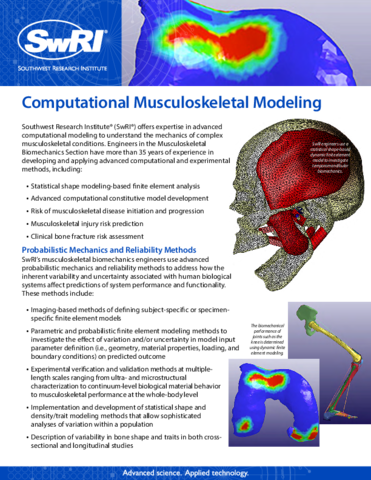We analyze and evaluate the complexity of musculoskeletal conditions to help solve critical problems in orthopaedics through advanced engineering. Our advanced computational model development helps us to investigate and reduce the risk of injury to military warfighters.
To understand the mechanics of complex musculoskeletal conditions staff at Southwest Research Institute (SwRI) develop and apply advanced computational methods, including:
- Statistical shape modeling based finite element analysis
- Advanced computational constitutive model development
- Risk of musculoskeletal disease initiation and progression
- Injury risk prediction
- SwRI engineers develop advanced parametric, probabilistic high fidelity finite element models of the musculoskeletal system to investigate and reduce the risk of injury to military warfighters.
- These models are developed using a hierarchical verification and validation methodology based on the ASME Solid Mechanics Verification and Validation Guidelines.
- Advanced probabilistic mechanics and reliability methods are being employed to address how the inherent variability and uncertainty associated with biological systems affects predictions of system performance and functionality. In one application, the probability of injury to the cervical spine (neck) of naval aviators caused by high acceleration maneuvers is being investigated.
- Fracture Risk
- Imaging-based methods of defining subject-specific or specimen-specific finite element models are commonly employed.
- Parametric and probabilistic finite element modeling methods are employed to investigate the effect of variation and/or uncertainty in model input parameter definition (i.e., geometry, material properties, loading, and boundary conditions) on predicted outcome.
- Experimental verification and validation methods are employed at multiple length scales ranging from ultra- and microstructural crack development to continuum level damage to loss of structural performance at the whole bone level.
- Statistical shape and density/trait modeling methods were developed and implemented and allow sophisticated analyses of variation within a set of bones.
- Variability of biological structures are captured by projecting a high-dimensional representation of the structure onto a lower dimensional subspace of possible shapes constructed from a set of shapes (e.g., bones, etc.)
- Variability in bone shape and traits can be described in both cross-sectional and longitudinal studies.
- Description of the spatial distribution of any measureable or determinable traits from any length scale can be incorporated in the models to investigate their role in fracture resistance.
- Finite element model parameters are defined once and applied to multiple subject-specific models without additional interaction.


